MALE & FEMALE
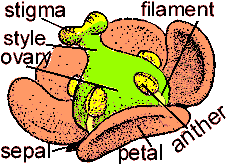
In flowers, it's like this:
- MALE PART: The stamen, which consists of a stalk-like filament, tipped with a bag-like anther.
- Anthers split open to release pollen.
- Pollen grains contain sperm, or male gametes
- FEMALE PART: The pistil, which consists of the ovary, usually topped by a style, which connects the ovary with stigma
- The female gametes reside inside ovules held within the ovary
- Rarely the ovary's style is missing
- Often the style's tip lacks a stigma but is "stigmatic" -- it functions as a stigma, and often, as in the Aster and Grass Families, bears tiny hairlike structures called "stigmatic papillae," as seen at the right at the tip of a corn silk, which is a style

POLLINATION
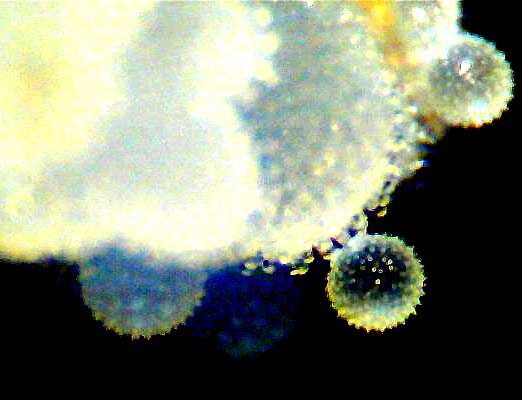
Pollination is the process of transferring pollen containing male gametes to the appropriate part of a pistil in a receptive flower. At the left, pollination has occurred in a flower of a Purple Morning-glory, Ipomoea purpurea. Spherical, spiky pollen grains are seen adhering to the surface of the flower's much larger stigma.

About 12% of the world's flowering plants are wind-pollinated, with nearly all the rest pollinated by animals, especially insects, and especially bees. This is worth thinking about in a world where more than 40% of the world's pollinators, mostly bees, are facing extinction (Download study).
FERTILIZATION
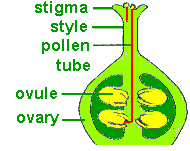
Once a pollen grain has arrived on the surface of a receptive stigma, it germinates, and sends a root-like pollen tube down through the style, all the way to a tiny ovule inside the ovary at the flower's bottom. 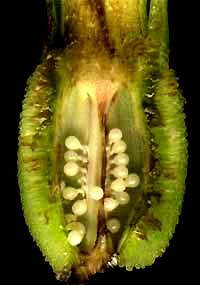 At the right you see ovules in a broken-open ovary of a garden Canna flower. The pollen tube transfers two male gametes into the ovule. One gamete fuses with the female gamete to form the embryo which later will become a new plant. The other male gamete is involved with the formation of endosperm, which will supply food to the developing embryo.
At the right you see ovules in a broken-open ovary of a garden Canna flower. The pollen tube transfers two male gametes into the ovule. One gamete fuses with the female gamete to form the embryo which later will become a new plant. The other male gamete is involved with the formation of endosperm, which will supply food to the developing embryo.
REPRODUCTION WITHOUT SEX

Many flowering plants reproduce without sex -- asexually. Potato plants can produce flowers and viable seeds, but normally they're grown by planting sections of potatoes containing "eyes." At the left a potato's eyes have begun developing bushy items, sprouts, that can form new plants. Several new plants could be grown from the potato in the picture.
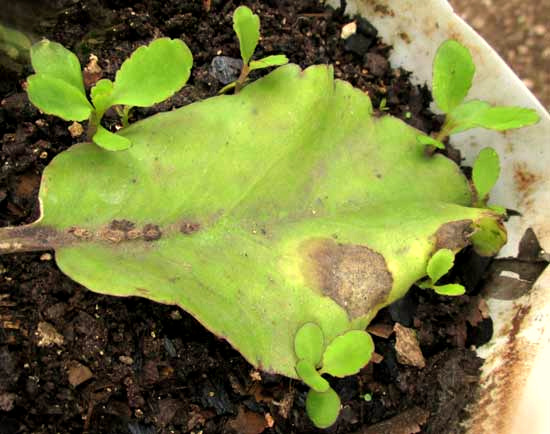
At the right, a leaf of Kalanchoe pinnata has fallen to the ground, and new plants are forming along the leaf's margin, no sex involved. The leaves of only a few plant species are capable of this.
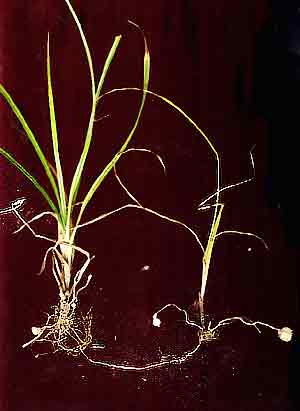
Many plants produce stolons, which are slender stem-branches running horizontally away from the main plant, either above or below ground. At the right, a stolon of a "mother" Nut Grass, Cyperus esculentus, has sent out a stolon from which a new plant is arising. Strawberry plants do the same.
One of the most interesting forms of asexual reproduction is variously called apomixis, polyembryony or nucellar embryony. In this process, often occurring in citrus species such as oranges and lemons, an embryo may arise in an ovule as if fertilization has occurred, though there has been no union of male and female gametes. The embryo arises from parts surrounding the embryo sac. It will lead to the formation of a seed inside a fruit just as if pollination and fertilization had occurred, but all its genetic material will be from the female gamete, with no contribution from a male.